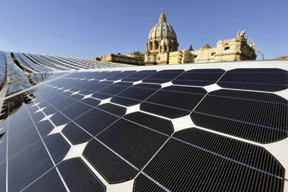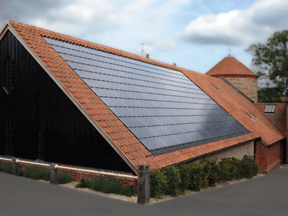By Michael Gorton
 The church saw its utility bills cut in half, with the solar panels projected to pay for themselves by 2018.
The church saw its utility bills cut in half, with the solar panels projected to pay for themselves by 2018.
Many churches across the country have begun to “go green” by installing solar energy systems to help clean up the environment and curb energy bills. Solar energy reduces the amount of fossil fuel used — the leading cause of climate change. This reduces air pollution and, as the use of solar energy increases, can have a positive impact on climate change.
Solar panel systems are designed to reduce energy costs, depending upon space, sunlight exposure and energy usage. A number of churches that have installed solar panels have seen lower electricity bills, sometimes cut in half, with the system paying for itself in a matter of years.
Five years ago First Presbyterian Church in Elko, NV, installed solar panels when the state of Nevada offered rebates to encourage solar energy. The initial cost of the installation was about $120,000; minus the $49,000 state rebate, the church only paid $71,000. After the installation, the church saw its utility bills cut in half, with the solar panels projected to pay for themselves by 2018.
Assessing solar needs
Key questions to consider before installing a solar energy system include:
Does your church receive enough exposure to the sun? This is a critical requirement for generating energy. Keep in mind that for solar panels to work, the entire panel must be exposed to sunlight.
How much power does your church need? To determine this, simply add up the kilowatt-hours (kWh) of electricity used on all electric bills for the past year. Electricity usage typically peaks in the summer months when the air conditioners run full blast. Electric bills in July and August are usually indicative of peak usage.
Is solar the right choice for your church? Unlike so many issues these days, solar is not a politically sensitive choice. It’s about saving the congregation money and improving the environment and the world we live in. The reality is that the installation of solar almost always saves the installer money in the long term, reduces the use of fossil fuels and often helps make utility budgeting more predictable.
Different approaches
Three main options to choose from when installing solar energy systems:
Outright Pu rchase – this approach requires a high upfront cost. At the moment, solar still costs between $3 and $4 per watt. An average home would cost $20,000 to $30,000 to power. A megachurch could cost millions for a big installation. That said, this approach is an excellent option during a building campaign if the funding is available. The average return on investment used to be approximately 17 years, but this has been decreasing as panel prices fall precipitously.
rchase – this approach requires a high upfront cost. At the moment, solar still costs between $3 and $4 per watt. An average home would cost $20,000 to $30,000 to power. A megachurch could cost millions for a big installation. That said, this approach is an excellent option during a building campaign if the funding is available. The average return on investment used to be approximately 17 years, but this has been decreasing as panel prices fall precipitously.
Power Purchase Agreement (PPA) – this is another good option. A PPA means the church only pays for the generated electricity that it uses, leaving the maintenance and operations to the seller.
Lease — this is similar to signing a PPA in that another entity owns the solar system. The church makes a flat monthly payment regardless of the electricity produced or consumed. The advantage is that the electric bill is the same every month.
All three options enable the church to provide environmental stewardship, have more predictable electric bills and frequently lower electric bills, as well.
Another critical motivator for installing solar for many church leaders is that of financial stewardship. A good example of this is Central Baptist Church in Wayne, PA. The congregation installed 48 solar panel arrays on the church roof to produce 9.6 kW of electricity and will supply approximately 30 percent of the 40,000 kWh of electricity that the church uses per year.
 In addition, the church invested in wind energy by purchasing about 2,500 kWh per month in wind blocks of renewable energy credits, ensuring that clean energy sources contributed to the local power grid. If they achieve their goal of reducing their total energy consumption by 7 percent, 100 percent of the electricity they consume will come from or support renewable energy.
In addition, the church invested in wind energy by purchasing about 2,500 kWh per month in wind blocks of renewable energy credits, ensuring that clean energy sources contributed to the local power grid. If they achieve their goal of reducing their total energy consumption by 7 percent, 100 percent of the electricity they consume will come from or support renewable energy.
The congregation estimates that if their solar panels generate 11,600 kWh of electricity per year, they will save about $1,740 annually at current electric rates. In addition, the church will receive one credit for every 1,000 kWh generated, about 12 credits per year. They expect to sell each credit for $200, which is $2,400 per year for all 12 credits generated.
At this rate, the congregation expects the solar system will pay for itself in only 4.8 years. The savings and revenue generated by the solar energy system can be used for community and mission work.
Michael Gorton is chief executive officer and chairman of Principal Solar, Addison, TX. www.PrincipalSolar.com



Hello, thanks for sharing this blog. this is very helpfull for me . if you want any help regarding solar maintenance then contact with Solar Medix. more detail click them.